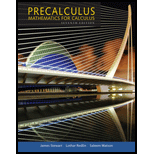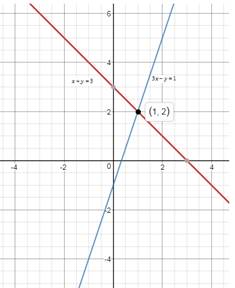
- (a) What are the three methods we use to solve a system of equations?
- (b) Solve the system by the elimination method and by the graphical method.
(a)
The three methods used to solve a system of equations.
Answer to Problem 1RCC
The three methods to solve a system of equations are Substitution Method, Elimination Method and Graphical Method.
Explanation of Solution
The first method is Substitution Method.
Solve any of the two given equations in terms of the other variable and substitute the value into the other equation then back substitute the value into the initial equation to determine the value of the variables.
The second method is Elimination Method.
Multiply the equations with a selected constant value to make coefficient of any of the two variable same with opposite sign and add the equations to get the value of one of the variables then back substitute the value into the initial equation to determine the value of the other variable.
The third method is Graphical Method.
Graph the given pair of equations and find the intersection point of the graphs . The x and y coordinates of the intersection point is the value of variables.
(b)
To evaluate: The solution of given equations using elimination method and graphical method.
Answer to Problem 1RCC
The solution is ordered pair
Explanation of Solution
Section1:
The given equations are,
Add the equation (1) and (2) to eliminate y, as the coefficients of y-term in both equations are negative to each other.
The value of x is 1.
Back-substitute 1 for x in equation (1) and find the value of y.
The value of y is 2.
Thus, the solution is ordered pair
Section2
The given equations are,
Substitute some value of y in equation (1) and make a table for values of x and y.
| x | y |
|
| 4 |
| 0 | 3 |
| 1 | 2 |
| 2 | 1 |
| 3 | 0 |
Substitute some value of y in equation (2) and make a table for values of x and y.
| x | y |
|
|
|
| 0 |
|
| 1 | 2 |
| 2 | 5 |
| 3 | 8 |
Plot the point from the tables and connect the points to make the graph of equation (1) and equation (2).

Figure (1)
From Figure (1), it can be noticed that the graph of two linear equations intersect at a single point.
Thus, the system of equations has one solution and the point of intersection is
Want to see more full solutions like this?
Chapter 10 Solutions
Precalculus: Mathematics for Calculus
- 3. We'd like to know the first time when the population reaches 7000 people. First, graph the function from part (a) on your calculator or Desmos. In the same window, graph the line y = 7000. Notice that you will need to adjust your window so that you can see values as big as 7000! Investigate the intersection of the two graphs. (This video shows you how to find the intersection on your calculator, or in Desmos just hover the cursor over the point.) At what value t> 0 does the line intersect with your exponential function? Round your answer to two decimal places. (You don't need to show work for this part.) (2 points)arrow_forwardSuppose the planet of Tattooine currently has a population of 6500 people and an annual growth rate of 0.35%. Use this information for all the problems below. 1. Find an exponential function f(t) that gives the population of Tattooine t years from now. (3 points)arrow_forwardA house was valued at $95,000 in the year 1988. The value appreciated to $170,000 by the year 2007. A) If the value is growing exponentially, what was the annual growth rate between 1988 and 2007? Round the growth rate to 4 decimal places. r = B) What is the correct answer to part A written in percentage form? r = 3 %.arrow_forward
- B G R + K Match each equation with a graph above - 3(0.9)* 1 a. green (G) 3(1.5)* b. black (K) 3(0.73)* c. blue (B) d. red (R) I ✪ 4(1.21)* - 3(1.21)* e. orange (O)arrow_forwardSuppose the planet of Tattooine currently has a population of 6500 people and an annual growth rate of 0.35%. Use this information for all the problems below.arrow_forwardTwo cables tied together at C are loaded as shown. Given: Q = 130 lb. 8 30° C B Q 3 4 Draw the free-body diagram needed to determine the range of values of P for which both cables remain taut.arrow_forward
- Cable AB is 103 ft long and the tension in the cable is 3900 lb. 56 ft A 50° 20° B x C Identify the angles 0.0, and 8, that define the direction of force. 1 By N 2 Match each of the options above to the items below. 142.1° 57.1° 73.3° 3 8.arrow_forwardIn the given figure, P = 51 lb . 65° C 25° 35° 75 lb P Determine the corresponding magnitude of the resultant. The corresponding magnitude of the resultant is| lb.arrow_forwardCable AB is 103 ft long and the tension in the cable is 3900 lb. 56 ft D y A B 20° 50° x C Identify the x, y, and z components of the force exerted by the cable on the anchor B. 1 F. FI 3 Fy 2 Match each of the options above to the items below. 2,120 lb 1,120 lb -3,076 lbarrow_forward
- In the given figure, P = 51 lb. 65° 25° 35° 75 lb P B Determine the required tension in cable AC, knowing that the resultant of the three forces exerted at point C of boom BC must be directed along BC. The required tension in cable AC is lb.arrow_forwardhelp on this question about Laplace transformation?arrow_forwardHelp me expand this fraction below.arrow_forward
 Glencoe Algebra 1, Student Edition, 9780079039897...AlgebraISBN:9780079039897Author:CarterPublisher:McGraw Hill
Glencoe Algebra 1, Student Edition, 9780079039897...AlgebraISBN:9780079039897Author:CarterPublisher:McGraw Hill Big Ideas Math A Bridge To Success Algebra 1: Stu...AlgebraISBN:9781680331141Author:HOUGHTON MIFFLIN HARCOURTPublisher:Houghton Mifflin Harcourt
Big Ideas Math A Bridge To Success Algebra 1: Stu...AlgebraISBN:9781680331141Author:HOUGHTON MIFFLIN HARCOURTPublisher:Houghton Mifflin Harcourt
 College Algebra (MindTap Course List)AlgebraISBN:9781305652231Author:R. David Gustafson, Jeff HughesPublisher:Cengage Learning
College Algebra (MindTap Course List)AlgebraISBN:9781305652231Author:R. David Gustafson, Jeff HughesPublisher:Cengage Learning Algebra for College StudentsAlgebraISBN:9781285195780Author:Jerome E. Kaufmann, Karen L. SchwittersPublisher:Cengage Learning
Algebra for College StudentsAlgebraISBN:9781285195780Author:Jerome E. Kaufmann, Karen L. SchwittersPublisher:Cengage Learning Holt Mcdougal Larson Pre-algebra: Student Edition...AlgebraISBN:9780547587776Author:HOLT MCDOUGALPublisher:HOLT MCDOUGAL
Holt Mcdougal Larson Pre-algebra: Student Edition...AlgebraISBN:9780547587776Author:HOLT MCDOUGALPublisher:HOLT MCDOUGAL





